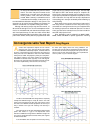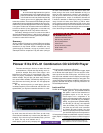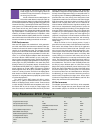
put). From the setup menus, you also select whether you want
16.9 formatted video output. This is called “wide,” which might
not be self-explanatory but the on-screen graphic makes the
meaning clear.
You can also select whether you want the digital audio out-
put to be 24 bit/48 kHz or 24 bit/96 kHz, the latter available only
on some DVDs. Older outboard DACs and digital preamps or
receivers will not accept 96 kHz bitstreams, so it is important
to pay attention to this. If you select the 48 kHz output in the
set-up menu, then any DVD audio track containing a 96 kHz sig-
nal will be downconverted to 48 kHz by the DVL-91 for back-
wards compatibility with older components. The DVL-91’s
internal DACs are 20 bit/96 kHz devices. The player will also
pass a DTS surround signal through its digital outputs. The set-
up menus allow you to configure such things as onscreen lan-
guages, menu colors, etc. One idiosyncrasy of the DVL-91, like
the Pioneer-based Theta Vo y a g e r, is that the set-up menus must
be accessed with a disc inserted, but stopped. The
kind of menu you get depends upon the kind of
disc you put in. The onscreen display, besides
having the usual chapter and time information,
includes a digital bit-rate meter, with both a bar
graph and numerical information. As with the
Theta Vo y a g e r , it is an accurate meter, unlike that on the Sony
p l a y e r s .
The front panel of the DVL-91 is sparsely populated with
controls. These include power, play, stop, forward, reverse,
side change (for LDs), display off, and the display itself. There
are also separate eject buttons for CD/DVD and LD. The
remote repeats all of these controls but has no separate eject
buttons, instead responding to what disc is in the machine or
which format was last used. The remote also contains menu
navigation controls, programming and search functions, a
numeric keypad, and a jog dial with shuttle ring. Unfortunate-
Pioneer Elite DV L-91
T
he Pioneer Elite DV L-91 is compared to the Th e t a Voya g e r
r ev i ewed in TPV 25, our Pioneer Elite DV-09 DVD refe r-
ence playe r, and the Pioneer Elite CLD-97, one of the best
s tandalone laserdisc players from a previous generation. Th e
DVD frequency response differences are insignificant. The DV L-
91 laserdisc playe r’s horizo n tal frequency response, like the Th e t a
Voya g e r , is excellent to 4 MHz (320 TV lines per picture height),
but then falls off rapidly at 5 MHz (400 T V L ) .
Frequency Response ( d B, MHz)
MHz 0.5 1. 0 2 . 0 3 . 0 4 . 0 5 . 0
DV L-91 DV D Y P b Pr 0 0 . 1 0 . 4 0 . 3 - 0 . 6 - 2 . 4
Voyager DVD Y P b Pr 0 . 0 0 . 1 0 . 4 0 . 4 - 0 . 3 - 2 . 0
DV-09 DVD Y P b Pr 0 . 0 0 . 1 - 0 . 2 0 . 2 - 0 . 3 - 1. 9
DV L-91 LD S - Vi d e o - 0 . 5 - 1. 0 - 1. 4 - 0 . 8 - 0 . 8 - 10 . 9
Voyager LD S - Vi d e o - 0 . 3 - 0 . 6 - 1. 2 - 0 . 9 - 0 . 9 - 9 . 0
CLD-97 LD S - Vi d e o - 0 . 3 - 0 . 5 - 1. 0 - 0 . 8 - 1. 9 - 8 . 9
The DV L- 9 1 ’s luminance noise is excellent for a laserdisc playe r
and will not be visible above the background noise of most
discs.
Signal to Noise (dB rm s ) Vi d e o L u m i n a n c e
C o m p o s i t e S - Video (Y/C)
DV L-91 Voyager LD CLD-97 DV L-91 Voyager LD CLD-97
15 kHz-Fu l l 4 9 . 2 4 9 . 7 4 9 . 8 5 0 . 1 5 0 . 8 5 0 . 1
NTC-7 wtd 5 4 . 2 5 5 . 2 5 5 . 7 5 4 . 8 5 5 . 9 5 5 . 8
The DV L- 9 1 ’s chroma noise did not equal the CLD-97, the best
of the standalone laserdisc players from a previous generation,
continuing the trend found in combi players. The noise is visible
on test patterns but somewhat less so on movies. Measure-
ments are for maximum chroma noise reduction settings since
no adverse effects were found using that setting and noise
i m p r ovements were significant. Chroma noise is far worse on
the composite video output, so use S-Video with laserdiscs.
Signal to Noise
(dB rms) AM Chroma Noise PM Chroma Noise
C o m p o s i t e DV L- 9 1 Voya g e r CLD-97 DV L- 9 1 Voyager CLD-97
L D L D
100 - 500 KHz 42.0 40.2 5 1.0 43.1 4 0 . 7 4 1. 0
100 Hz - 1 MHz 40.2 3 8 . 5 4 5 . 9 4 0 . 5 3 8 . 2 4 0 . 2
S - Video (Y/C)
100 Hz - 500 KHz 5 1. 1 5 0 . 2 5 4 . 1 4 5 . 6 4 0 . 6 4 7. 0
100 Hz - 1 MHz 4 8 . 4 4 5 . 3 5 1. 7 4 3 . 5 3 8 . 8 4 6 . 5
DVD component-video noise performance is excellent.
S - V ideo noise levels are ve ry good and shouldn’t be visible on
a n y discs. But Y P b P r component video should always be used
to get the best chroma bandwidth and color deta i l .
Signal to Noise
(dB rms) S - Vi d e o Y P b P r
U nwe i g h t e d Y C - A M C - P M Y P b Pr
DV L- 9 1 DV D 7 2 . 1 5 6 . 1 4 9 . 2 74 . 7 7 7. 1 7 5 . 8
Voya g e r DV D 74 . 7 6 9 . 9 4 8 . 8 74 . 6 8 0 . 0 7 7. 5
DV- 0 9 7 5 . 9 6 6 . 0 4 5 . 6 7 5 . 4 74 . 8 7 5 . 5
Component-video signal alignment was excellent. A 12 nS
luma to color- d i f ference signal delay is less than 1/6 pixe l .
YPbPr Delay ( n S ) Pb to Y Pr to Y Pb to Pr
DV L- 9 1 - 11. 8 - 11. 6 - 0 . 2
Voyager DV D - 18 . 2 - 17. 2 - 1. 0
DV- 0 9 3 1. 8 - 4 2 . 9 74 . 7
Convergence Laboratories Test Report
Greg Rogers
-12
-10
-8
-6
-4
-2
0
2
0.5
MHz
1.0
MHz
2.0
MHz
3.0
MHz
4.0
MHz
5.0
MHz
Frequency Response
dB
Voyager DVD YPbPr
Voyager LD S-Video
CLD-97 LD S-Video
DVL-91 LD S-Video
DVL-91 DVD YPbPr
Frequency Response


















